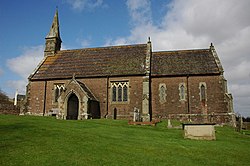Ganarew
| Ganarew | |
| Herefordshire | |
|---|---|
 Church of St Swithin, Ganarew | |
| Location | |
| Grid reference: | SO530162 |
| Location: | 51°50’35"N, 2°40’59"W |
| Data | |
| Population: | 171 (2011) |
| Post town: | Monmouth |
| Postcode: | NP25 |
| Local Government | |
| Council: | Herefordshire |
| Parliamentary constituency: |
Hereford and South Herefordshire |
Ganarew is a village in the very south of Herefordshire, ajoinjing the border of Monmouthshire. The River Wye flows to the south-east of the village and here forms the county boundary.
The village is located half a mile south-west of the village of Whitchurch, beside the main A40 trunk road to Monmouth. The nearest town is Monmouth, two miles away, while Ross-on-Wye is eight miles away.
The most noteworthy buildings in the village are contains the Church of St Swithin and Ganarew Manor.
The name of Ganarew is from the Welsh language, from Genau'r Rhiw' (‘mouth of the hill’), the mouth indicating a mouth or opening of a pass.
History
The Imperial Gazetteer of 1855 recorded Ganarew's population as 147, and that its parish as of 835 acres.[1] In 1868, the National Gazetteer noted that there was an observatory, 70 feet high, on the summit of nearby Little Doward Hill (or Ganarew Hill),[2] from the top of which a view could be obtained of the Bristol Channel.[3] By 1904, The Survey Gazetteer recorded the population as 132, and that there were 848 acres.[4]
Legend
King Vortigern is said to have made his last stand against Aurelius at Ganarew. Lawman calls it a castle on Cloard Hill in the district of Hergin, and has Vortigern dying after the castle was besieged and fired by Aurelius and Uther.[5]
A cave, at nearby Little Doward, known as "King Arthur's Cave" can be explored, making it unique amongst candidates for the Arthurian cave legend. Helen Hill Miller in her 1969 The Realms of Arthur, suggests a military use for the cave, arguing that the cave's "recesses penetrate very far into the hill, and could hide a substantial force". The cave has a parallel with Cadbury Castle in that it is a cave within a hillfort. It was first inhabited in the Old Stone Age and is thus older than any other Arthurian site.[6]
Parish church
The parish church, St Swithin is within Diocese of Hereford.[7] A Grade II listed building,[8] it was rebuilt[9] in about 1850 by John Prichard.

The graveyard contains a Gothic pinnacle[10] memorial to the Bannerman family who lived nearby at Wyastone Leys.
The Church of St Swithin churchyard contains a standing stone cross, of stepped form, which is a scheduled historical monument.[11] It is principally mediæval with some later additions and includes the foundation, the base of two steps and a socket stone. The shaft, knop and head are modern.
About the village

Ganarew Manor dates from the 17th century, with mid 19th and early 20th century alterations.[12] The house is of stone with a slate roof, the 20th century extensions including a two-storey block with a bay window and a gabled porch.[13]
The house is a Grade II listed building. The gate to the manor, with accompanying piers, is also a Grade II listed structure.[14]
Other ancient monuments are noted at Ganarew Cross,[15] and at Little Doward camp, the remains of an Iron Age hillfort.[16]
The Wye Valley Walk passes close to the south of the camp.
Transportation
In 1755 a road was constructed from Monnow Bridge to Gan y Rew. In the late 18th century, the turnpike route to Ross in the area of Ganarew Hill was described as being in such bad condition that it was a travel danger. The Hereford Trust took over road work for the section between Old Forge and Ganarew in 1819. Plans in the early 19th century to build a connecting road between St. Weonards and Ganarew were not carried out.[17]
Outside links
| ("Wikimedia Commons" has material about Ganarew) |
References
- ↑ Blackie, Walter Graham (1855). The imperial gazetteer: a general dictionary of geography, physical, political, statistical and descriptive ... (Public domain ed.). Blackie. pp. 1055–. https://books.google.com/books?id=8ewDAAAAQAAJ&pg=PA1055. Retrieved 25 March 2012.
- ↑ Murray, John (1872). A handbook for travellers in Gloucestershire, Worcestershire, and Herefordshire ... (Public domain ed.). J. Murray. pp. 324–. https://books.google.com/books?id=XLaMuyFN-bQC&pg=PA324. Retrieved 25 March 2012.
- ↑ "Extract from National Gazetteer, 1868" at genuki.org.uk
- ↑ Bartholomew, John George (1904). The survey gazetteer of the British Isles, topographical, statistical, and commercial: compiled from the 1901 census and the latest official returns (Public domain ed.). G. Newnes, limited. pp. 314–. https://books.google.com/books?id=kSYOAQAAMAAJ&pg=PA314. Retrieved 25 March 2012.
- ↑ "Caer Guorthegirn", by Robert Vermaat, at vortigernstudies.org.uk
- ↑ "Arthur's Cave near Little Doward, Ganarew", by Joe Boyles and Jake Livingston, at vortigernstudies.org.uk
- ↑ "Ganarew: St Swithin, Ganarew" at achurchnearyou.com
- ↑ Church of St Swithin, Ganarew - British Listed Buildings
- ↑ Royal Commission on Historical Monuments (England); Crawford, David Lindsay (1934). An inventory of the historical monuments in Herefordshire. H. M. Stationery off., printed by William Clowes & sons, ltd.. p. 96. https://books.google.com/books?id=xgZNAAAAMAAJ. Retrieved 25 March 2012. "Parish Church of St. Swithin, was entirely rebuilt in 1850..."
- ↑ Pevsner, Nikolaus (1963). Herefordshire. Yale University Press. pp. 134–. ISBN 978-0-14-071025-0. https://books.google.com/books?id=B5ANBpiLHl0C&pg=PA134. Retrieved 25 March 2012.
- ↑ National Heritage List 1016117: Churchyard Cross in St Swithin's Churchyard
- ↑ National Heritage List 1099452: Ganarew Manor
- ↑ The Manor House, Ganarew - British Listed Buildings
- ↑ Gate Piers and Gate to Manor House, Ganarew - British Listed Buildings
- ↑ National Heritage List 1016118: Ganarew Cross
- ↑ National Heritage List 1001766: Little Doward Camp
- ↑ Hurley, Heather (30 September 2007). The Old Roads of South Herefordshire. Fineleaf Editions. pp. 47, 49, 74. ISBN 978-0-9534437-4-1. https://books.google.com/books?id=jTaWk2RsMNEC. Retrieved 25 March 2012.